- ¿Qué es un parque nacional?
-
- Mar de las Calmas (propuesta)
- Aigüestortes i Estany de Sant Maurici
- Cabrera Archipelago
- Cabañeros
- Caldera de Taburiente
- Doñana
- Garajonay
- Atlantic Islands of Galicia
- Monfragüe
- Ordesa y Monte Perdido
- Picos de Europa
- Sierra de Guadarrama
- Sierra de las Nieves
- Sierra Nevada
- Tablas de Daimiel
- Teide
- Timanfaya
- La Red de un vistazo
- ¿Cómo funciona La Red?
- Cartography
- Central Booking
Transectos: Tajo del Halcón
Transectos: Tajo del Halcón
 Resumen de las observaciones realizadas en cada metro de profundidad en Tajo del Halcón (Chafarinas). Autor: Luis Sánchez Tocino. Universidad de Granada
Resumen de las observaciones realizadas en cada metro de profundidad en Tajo del Halcón (Chafarinas). Autor: Luis Sánchez Tocino. Universidad de Granada
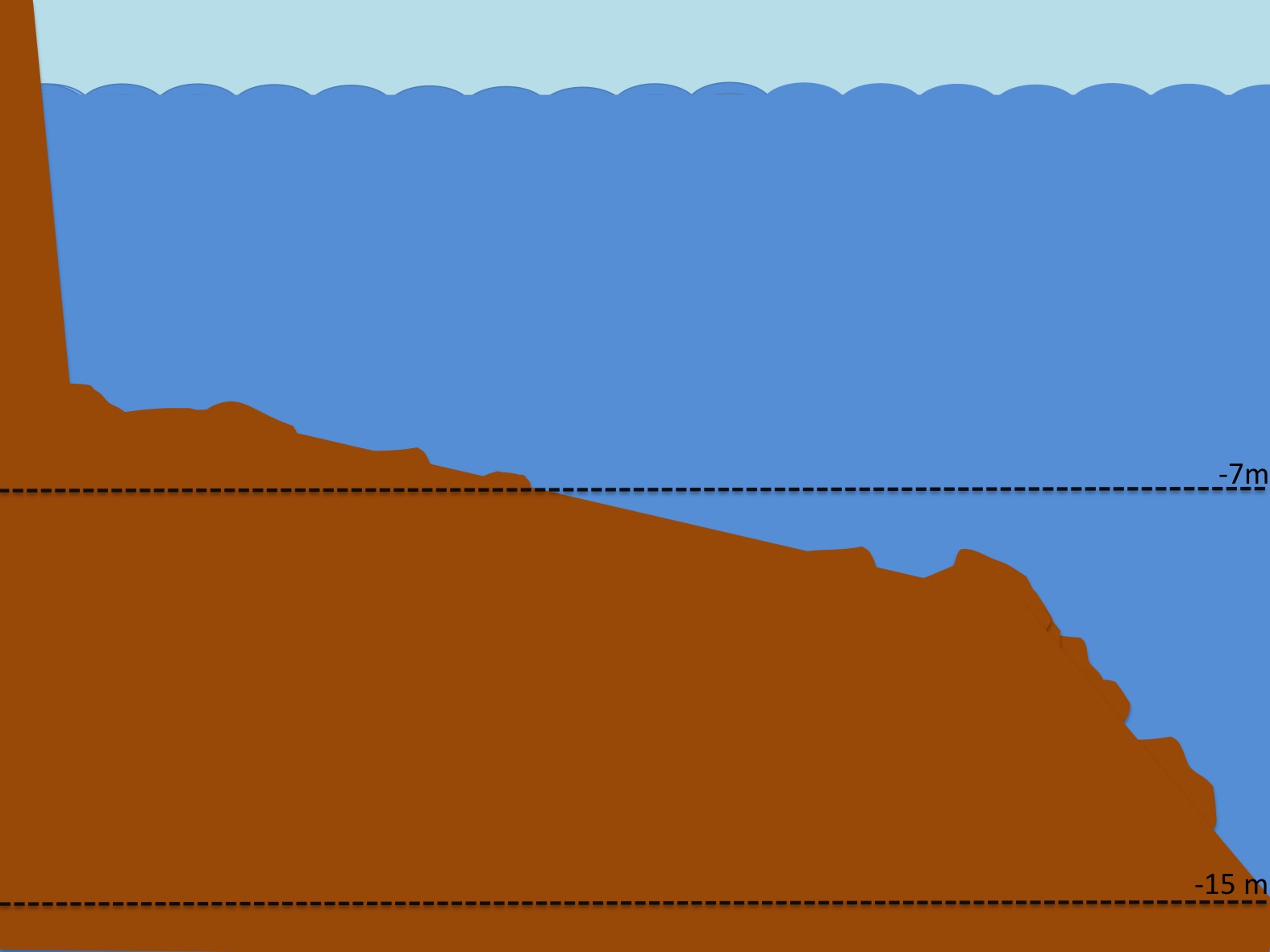 Representación del relieve del terreno en Tajo del Halcón
Representación del relieve del terreno en Tajo del Halcón
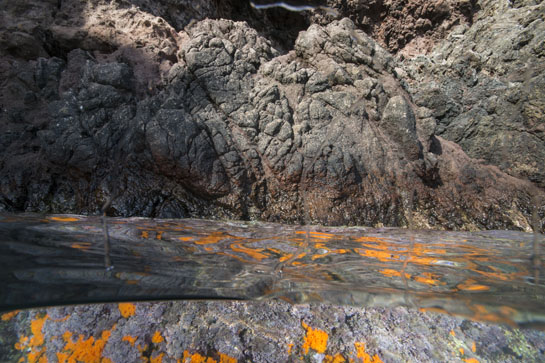 0m. En la imagen se aprecia como predominan el alga roja Corallina elongata y el coral naranja Astroides calycularis.
0m. En la imagen se aprecia como predominan el alga roja Corallina elongata y el coral naranja Astroides calycularis.
 0m. El tomate de mar, Actinia equina, es una anémona típica del mediolitoral. En la fotografía se pueden ver varios ejemplares, justo en el límite superior del cinturón del alga rojaCorallina elongata.
0m. El tomate de mar, Actinia equina, es una anémona típica del mediolitoral. En la fotografía se pueden ver varios ejemplares, justo en el límite superior del cinturón del alga rojaCorallina elongata.
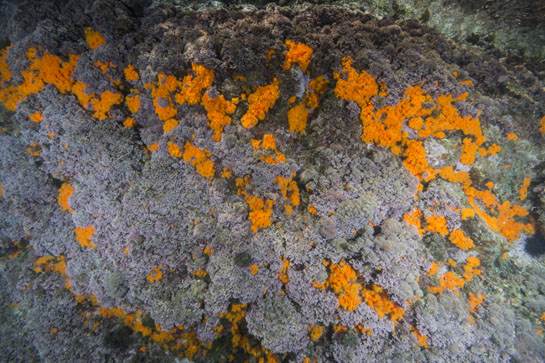 –1m. La umbría, debido a la orientación y a la altura de las paredes del Tajo del Halcón, favorece la presencia del coral naranja, el cual compite por el sustrato con las algas rojas.
–1m. La umbría, debido a la orientación y a la altura de las paredes del Tajo del Halcón, favorece la presencia del coral naranja, el cual compite por el sustrato con las algas rojas.
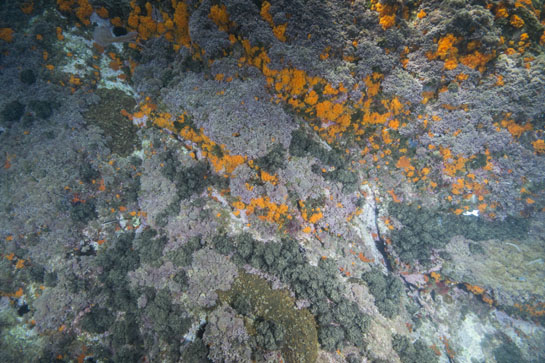 –2m. Con el aumento de la profundidad aparecen los primeros ejemplares del alga parda Halopteris scoparia. En la parte inferior central se distingue, por su color verde debido a la presencia de zooxantelas, una colonia del coral Oculina patagonica.
–2m. Con el aumento de la profundidad aparecen los primeros ejemplares del alga parda Halopteris scoparia. En la parte inferior central se distingue, por su color verde debido a la presencia de zooxantelas, una colonia del coral Oculina patagonica.
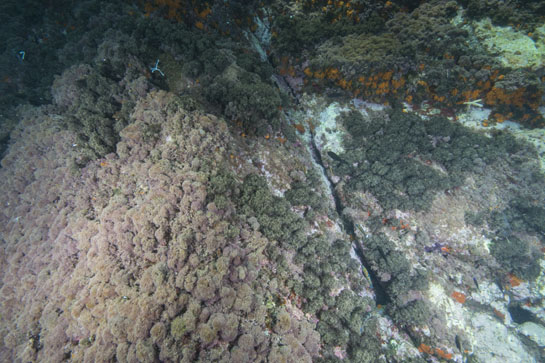 –3m. Las primeras gorgonias de la especie Eunicella singularis aparecen a tan escasa profundidad debido a la umbría del Tajo. También se observan nadando varias castañuelas , Chromis chromis, y fredis, Thalassoma pavo.
–3m. Las primeras gorgonias de la especie Eunicella singularis aparecen a tan escasa profundidad debido a la umbría del Tajo. También se observan nadando varias castañuelas , Chromis chromis, y fredis, Thalassoma pavo.
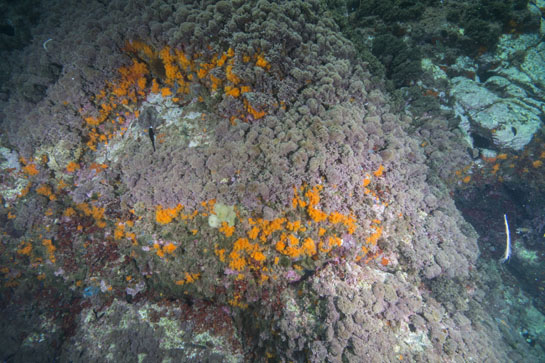 –4m. Unos pequeños extraplomos permiten que las colonias de coral naranja, Astroides calycularis, ganen, en su pulso por el sustrato, a las algas rojas.
–4m. Unos pequeños extraplomos permiten que las colonias de coral naranja, Astroides calycularis, ganen, en su pulso por el sustrato, a las algas rojas.
 –5m. La verticalidad, es este tramo del transecto, permite la presencia de algas rojas del género Peyssonnelia, junto al coral naranja, Astroides calycularis, y el alga verde, Flabellia petiolata.
–5m. La verticalidad, es este tramo del transecto, permite la presencia de algas rojas del género Peyssonnelia, junto al coral naranja, Astroides calycularis, y el alga verde, Flabellia petiolata.
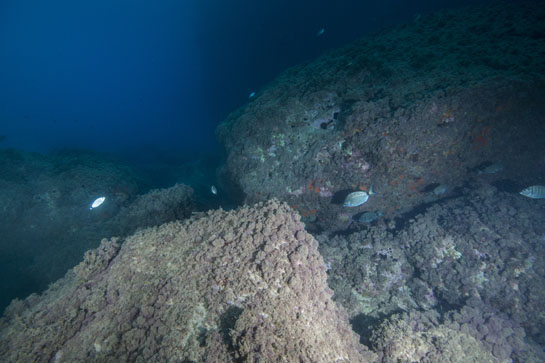 –6m. La pared vertical da lugar a un fondo con grandes bloques cubiertos principalmente por el alga parda Halopteris scoparia. En la imagen se pueden ver varios peces pertenecientes a la familia Sparidae: sargo común (Diplodus sargus,), sargo picudo (Diplodus puntazzo) y una oblada (Oblada melanura).
–6m. La pared vertical da lugar a un fondo con grandes bloques cubiertos principalmente por el alga parda Halopteris scoparia. En la imagen se pueden ver varios peces pertenecientes a la familia Sparidae: sargo común (Diplodus sargus,), sargo picudo (Diplodus puntazzo) y una oblada (Oblada melanura).
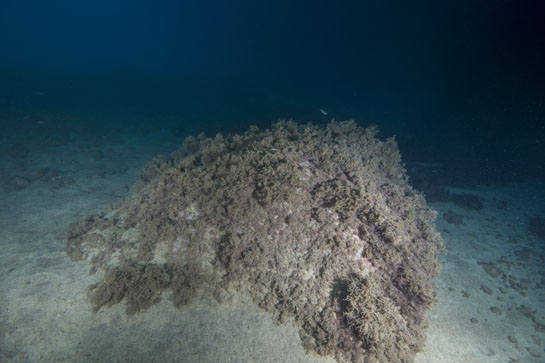 –7m. Grandes bloques de piedra se alternan con fondos blandos.
–7m. Grandes bloques de piedra se alternan con fondos blandos.
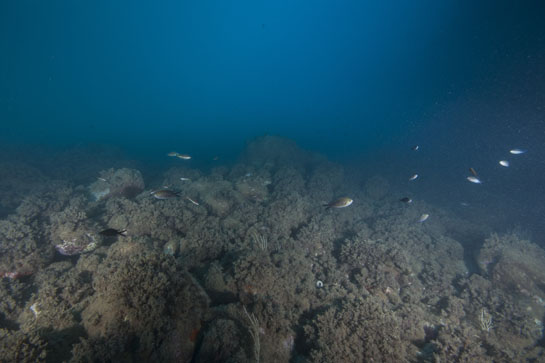 –8m. Sobre los bloques de piedra, cubiertos mayoritariamente por el alga parda Halopteris scoparia, nadan un grupo de castañuelas (Chromis chromis).
–8m. Sobre los bloques de piedra, cubiertos mayoritariamente por el alga parda Halopteris scoparia, nadan un grupo de castañuelas (Chromis chromis).
 –9m. El aumento de la profundidad trae consigo un incremento del número de ejemplares de la gorgonia Eunicella singularis.
–9m. El aumento de la profundidad trae consigo un incremento del número de ejemplares de la gorgonia Eunicella singularis.
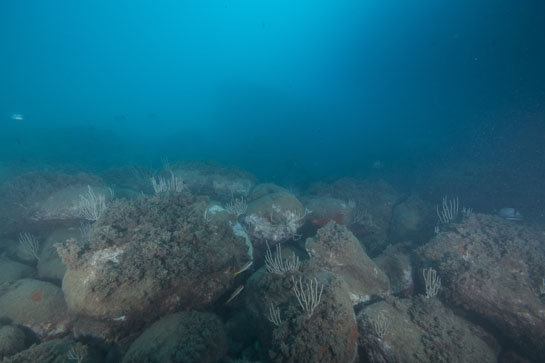 –10m. En la parte exterior del tajo vuelven los grandes bloques de piedra. Nadando entre ellos se observan diferentes especies de peces: mojarras(Diplodus vulgaris) y salmonetes (Mullus surmuletu).
–10m. En la parte exterior del tajo vuelven los grandes bloques de piedra. Nadando entre ellos se observan diferentes especies de peces: mojarras(Diplodus vulgaris) y salmonetes (Mullus surmuletu).
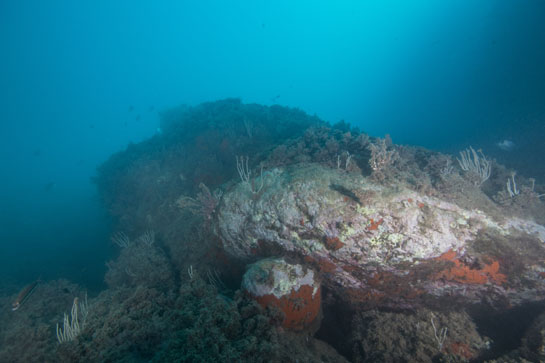 –11m. Las esponjas rojas aprovechan los extraplomos para desarrollarse. En la fotografía se observan varios ejemplares del la gorgonia Eunicella singularis total o parcialmente cubiertas por otros organismos.
–11m. Las esponjas rojas aprovechan los extraplomos para desarrollarse. En la fotografía se observan varios ejemplares del la gorgonia Eunicella singularis total o parcialmente cubiertas por otros organismos.
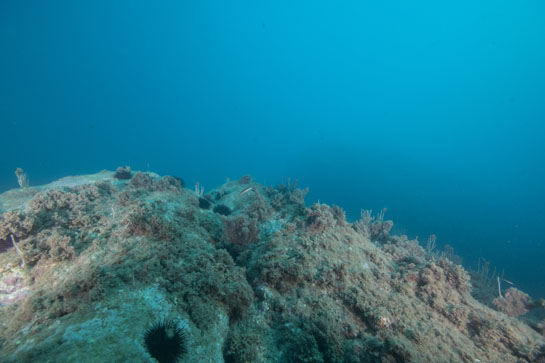 –10m. Los erizos, principalmente el erizo negro (Arbacia lixula) y el erizo común (Paracentrotus lividus), dejan grandes zonas blanquecinas dando lugar a la denominada Comunidad de Algas Calcáreas y Erizos.
–10m. Los erizos, principalmente el erizo negro (Arbacia lixula) y el erizo común (Paracentrotus lividus), dejan grandes zonas blanquecinas dando lugar a la denominada Comunidad de Algas Calcáreas y Erizos.
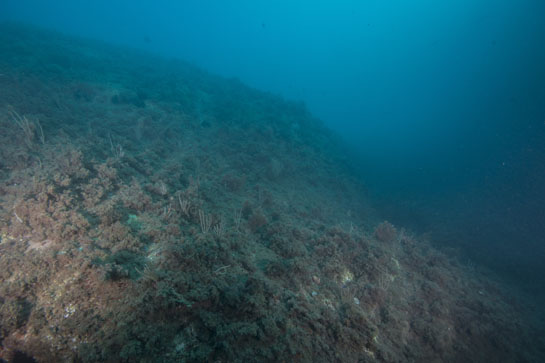 –11m. Si comparamos esta fotografía con la de los transectos realizados en el 2014, en el cercano Tajo del Cementerio, se puede apreciar la gran mortandad que se ha producido, desde entonces, en la población de la gorgonia Eunicella singularis.
–11m. Si comparamos esta fotografía con la de los transectos realizados en el 2014, en el cercano Tajo del Cementerio, se puede apreciar la gran mortandad que se ha producido, desde entonces, en la población de la gorgonia Eunicella singularis.
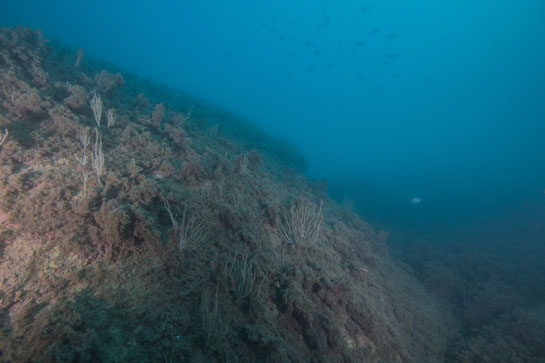 –12m. En la parte exterior del Tajo, la turbidez del agua aumenta rápidamente con la profundidad.
–12m. En la parte exterior del Tajo, la turbidez del agua aumenta rápidamente con la profundidad.
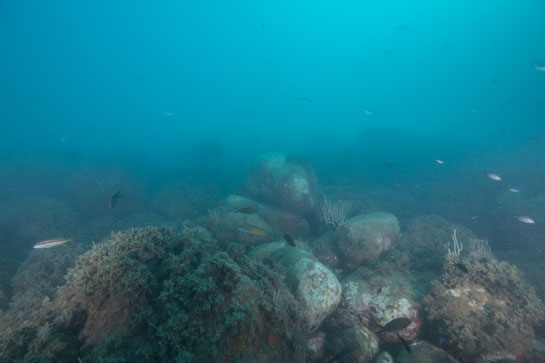 –13m. Salmonetes (Mullus surmuletus), fredis (Thalassoma pavo) y sobre todo castañuelas (Chromis chromis) nadan sobre los bloques de piedra del exterior del Tajo.
–13m. Salmonetes (Mullus surmuletus), fredis (Thalassoma pavo) y sobre todo castañuelas (Chromis chromis) nadan sobre los bloques de piedra del exterior del Tajo.
 –14m. Un erizo común (Paracentrotus lividus) ramonea en la parte vertical de un bloque de piedra cubierto de algas rojas calcáreas y esponjas rojas.
–14m. Un erizo común (Paracentrotus lividus) ramonea en la parte vertical de un bloque de piedra cubierto de algas rojas calcáreas y esponjas rojas.
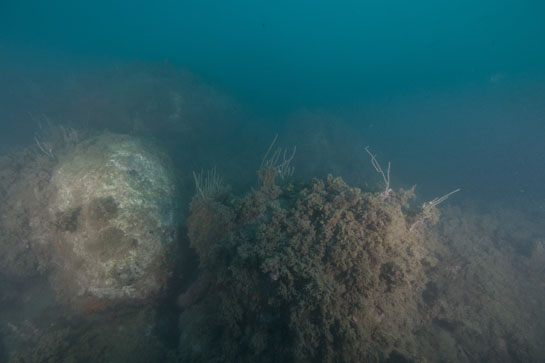 –15m. El transecto continúa con grandes bloques de piedra hasta unos 25 m de profundidad, pero la escasa visibilidad del agua impidió la toma de fotografías.
–15m. El transecto continúa con grandes bloques de piedra hasta unos 25 m de profundidad, pero la escasa visibilidad del agua impidió la toma de fotografías.
This page provides information on cookies we use: We use our own and third-party cookies to keep your session active, personalise your experience, and collect anonymous statistics about how you use this website. You can choose to accept all cookies or select which types you'd like to allow. To learn more about the cookies we use, read our Cookies Policy.
We use two types of cookies on this site. First, there are Functional Cookies, which are essential for the website to work properly. They store session data to make your experience smoother and more convenient. On the other hand, Analytical Cookies collect information about how you use the portal, without personal data, helping us provide a better and more tailored service.
Introduction to the Use of Cookies on the MITECO.gob.es Website
Cookies are small files that are stored on your device when you visit a webpage. They are essential tools that help provide many of the services available on the information society. Among other things, cookies allow a webpage to store and retrieve information about a user's browsing habits or their device. Based on this information, they can be used to recognise the user and enhance the service provided.
Types of Cookies
Depending on the entity that manages the domain from which the cookies are sent and processes the data, there are two types of cookies: first-party cookies and third-party cookies.
There is also a second classification based on how long the cookies remain stored in the user's browser: session cookies and persistent cookies.
Finally, cookies can also be classified into five types based on the purpose for which the data is processed: technical cookies, personalisation cookies, analytics cookies, advertising cookies, and behavioural advertising cookies.
For more information on this, you can refer to the Guide on the use of cookies from the Spanish Data Protection Agency.
Cookies used on the website
The web portal of the Ministry for Ecological Transition and the Demographic Challenge uses Adobe Analytics, an analytics tool that helps website and application owners understand how visitors interact with their content. Adobe Analytics uses a small number of cookies to collect data and generate usage statistics for websites. This information is sent anonymously and is not shared with third parties under any circumstances. You can choose to accept or reject these cookies, as they do not affect the portal’s functionality. However, they help provide valuable information that allows us to offer a better and more tailored service. For more information about Adobe Analytics cookies and privacy, please refer to the following links:
Additionally, pages featuring content from social network X will only set cookies if the user is logged into the X site. For more details on these cookies, please refer to the following link: Privacy on Social Network X
Finally, a technical cookie named MITECO-compliance is stored, which is a first-party, technical, and session-based cookie. It manages user consent for the use of cookies on the website, remembering which users have accepted them and which have not, ensuring that those who have accepted are not shown cookie consent messages at the top of the page. This cookie is essential for the proper functioning of the portal.
Cookies Policy Acceptance / Rejection
The Ministry for Ecological Transition and the Demographic Challenge gives you the option to accept or reject cookies that are not essential for the portal's operation. Upon accessing the portal, a message will be displayed in the centre of the page with information about the cookie policy and the following options:
· Firefox
· Chrome
· Safari